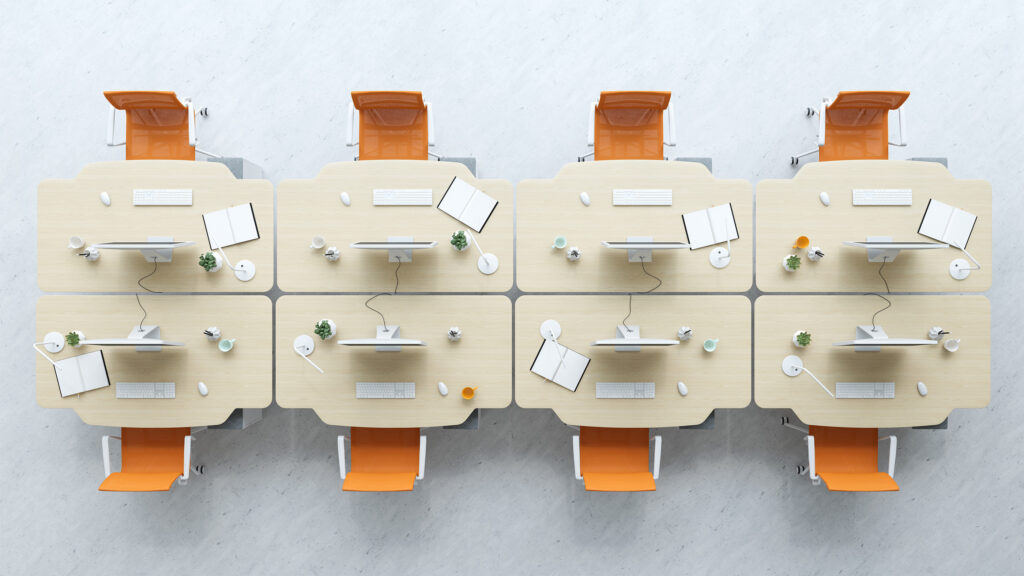The rise of hybrid working has led to a growing number of companies offering occupancy measurement for corporate real estate, but not all the technologies being employed are as reliable as their backers claim.
As the pioneers of desk sensor technology for more than two decades, we have a proven solution that is delivering for corporate clients worldwide in the new normal.
Yet we have seen some new entrants claiming that other technologies are superior. They aren’t.
Take optical sensors.
We’ve got you covered – optical sensors don’t always
Optical sensors are ceiling-mounted while desk sensors are fitted under desks. Because the optical sensor’s field of view is larger than one desk, it’s argued that you will need to invest in a lot more desk sensors than you would need to buy optical sensors to survey your office space.
Companies selling optical sensors frequently claim that they can provide sensor coverage of an office floor with just a few sensors. In fact, when ceiling-mounted sensors are spread apart, there are lots of potential blind spots.
To eliminate those requires far more sensors than typically advertised, and because of the way that optical sensors ‘see’ (essentially in circles), they can’t see all your floorspace without a huge amount of overlap.

Spy in the sky
Companies that sell optical sensors are at pains to point out that the camera in the equipment is modified so that it doesn’t have enough resolution to recognise faces.
Still, there is potentially nothing to stop anyone with the necessary skills restoring the higher definition settings and turning those ceiling-mounted video cameras into spies in the sky.
Blurred vision
But let’s say a camera-based system is configured to capture blurred images, as the sellers claim.
The obvious implication is that the camera image will require interpretation. Vendors often claim they can do this using artificial intelligence but blurred data can obviously be misinterpreted.
Not very intelligent
Proponents counter that they have developed artificial intelligence (AI) to work out what the hazy pictures mean. Quality desk-mounted infrared sensors don’t need AI to deliver correct ‘absolute’ data. There’s no room for mistakes.
AI gives marketers a sexy idea to play with (and bump up the asking price) but it’s not necessary unless sensors aren’t providing clear data. Even then, we’d question whether it can really sort the wheat from the chaff. More critically, the source data from these ceiling mounted technologies is typically deleted to overcome GDPR issues. Now the end users or their consultants don’t have any way to check reports against source data. They have no choice but to accept reports at face value.
Passive aggressive
One supposed benefit of video sensors is that they can detect “passive occupation”, that is objects commonly used by people to occupy spaces when they are not present such as backpacks, laptops, and clothing.
An example that is often cited is of a person at a desk who then goes to a meeting room but leaves a backpack indicating they are planning to return. This, say passive occupancy boosters, means the space is still occupied. But is it?
According to a study by CBRE, 50 per cent of office space is passively occupied in this way. That’s a huge amount of real estate to report as being in use when there is no one there.
In any case, the example given of a backpack, doesn’t consider that its owner may be sitting at one desk and has deposited the backpack on the neighbouring seat. Or how about the person who leaves a jacket on the back of the chair to indicate he is at work when he is actually in the pub? These are all examples of business rules, not absolute measurement.
Read the manual
This so-called passive occupancy not only generates spurious data via optical sensors. It also messes up manual studies when consultants walk around offices with clipboards looking for signs of life.
Industry insiders have long known that this pen and paper or “bed check” approach is fatally blinkered.
Experts, including Abintra, have spent a lot of time and effort to educate the market about the relative benefits of infrared sensors and number-crunching software to do the job of measuring occupancy ultra-accurately and in real-time.
Now there is a battle to set the record straight about the advantages of infrared versus optical sensors.
Off schedule
Sensing perhaps (excuse the pun) that they are losing the argument, the optical sensor lobby brings up the question of scheduling.
What would happen, it asks, if a scheduling system tied to occupancy sensors showed a desk as available when someone is planning to return to it. Would there be an awkward encounter when another member of staff moved the offending rucksack and sat there only to be confronted by the person returning?
Well, of course not. If it’s booked for the full period, the scheduling system will show it as unavailable.
When you compare data from the scheduling system to data from desk and meeting room sensors, you can see if space is being misused. For example, booking a desk for the full day but spending most of the day in a meeting room for 12 people with only one other person.
Last word
Supposedly combining passive occupancy data with active occupancy data will allow you to better plan redesigns and cleaning schedules. But it actually means you’ll be basing expensive real estate decisions on inaccurate measurements of occupancy and wasting time cleaning areas that no one has used.
